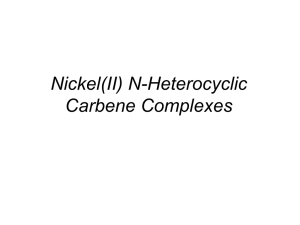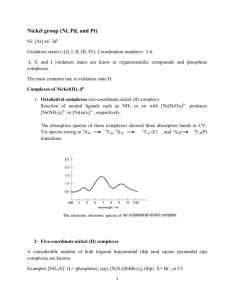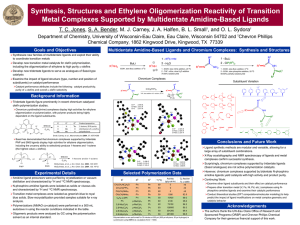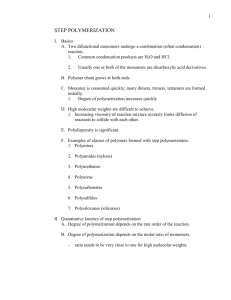Template for Electronic Submission to ACS Journals
advertisement
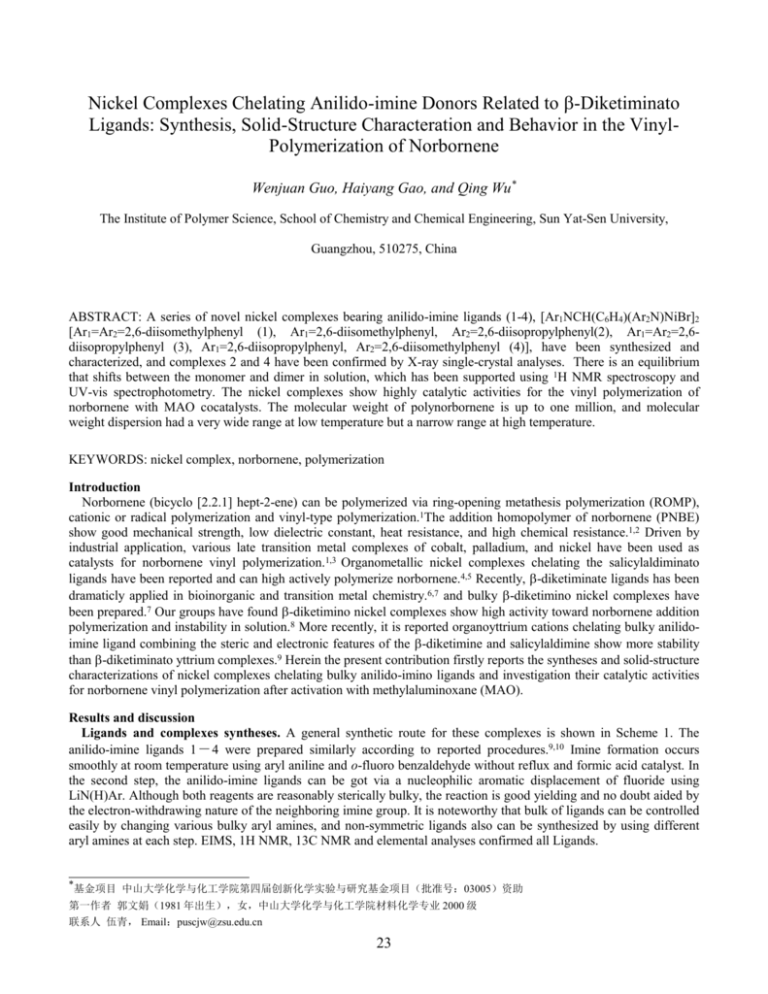
Nickel Complexes Chelating Anilido-imine Donors Related to -Diketiminato Ligands: Synthesis, Solid-Structure Characteration and Behavior in the VinylPolymerization of Norbornene Wenjuan Guo, Haiyang Gao, and Qing Wu* The Institute of Polymer Science, School of Chemistry and Chemical Engineering, Sun Yat-Sen University, Guangzhou, 510275, China ABSTRACT: A series of novel nickel complexes bearing anilido-imine ligands (1-4), [Ar1NCH(C6H4)(Ar2N)NiBr]2 [Ar1=Ar2=2,6-diisomethylphenyl (1), Ar1=2,6-diisomethylphenyl, Ar2=2,6-diisopropylphenyl(2), Ar1=Ar2=2,6diisopropylphenyl (3), Ar1=2,6-diisopropylphenyl, Ar2=2,6-diisomethylphenyl (4)], have been synthesized and characterized, and complexes 2 and 4 have been confirmed by X-ray single-crystal analyses. There is an equilibrium that shifts between the monomer and dimer in solution, which has been supported using 1H NMR spectroscopy and UV-vis spectrophotometry. The nickel complexes show highly catalytic activities for the vinyl polymerization of norbornene with MAO cocatalysts. The molecular weight of polynorbornene is up to one million, and molecular weight dispersion had a very wide range at low temperature but a narrow range at high temperature. KEYWORDS: nickel complex, norbornene, polymerization Introduction Norbornene (bicyclo [2.2.1] hept-2-ene) can be polymerized via ring-opening metathesis polymerization (ROMP), cationic or radical polymerization and vinyl-type polymerization.1The addition homopolymer of norbornene (PNBE) show good mechanical strength, low dielectric constant, heat resistance, and high chemical resistance.1,2 Driven by industrial application, various late transition metal complexes of cobalt, palladium, and nickel have been used as catalysts for norbornene vinyl polymerization.1,3 Organometallic nickel complexes chelating the salicylaldiminato ligands have been reported and can high actively polymerize norbornene.4,5 Recently, -diketiminate ligands has been dramaticly applied in bioinorganic and transition metal chemistry.6,7 and bulky -diketimino nickel complexes have been prepared.7 Our groups have found -diketimino nickel complexes show high activity toward norbornene addition polymerization and instability in solution.8 More recently, it is reported organoyttrium cations chelating bulky anilidoimine ligand combining the steric and electronic features of the -diketimine and salicylaldimine show more stability than -diketiminato yttrium complexes.9 Herein the present contribution firstly reports the syntheses and solid-structure characterizations of nickel complexes chelating bulky anilido-imino ligands and investigation their catalytic activities for norbornene vinyl polymerization after activation with methylaluminoxane (MAO). Results and discussion Ligands and complexes syntheses. A general synthetic route for these complexes is shown in Scheme 1. The anilido-imine ligands 1-4 were prepared similarly according to reported procedures.9,10 Imine formation occurs smoothly at room temperature using aryl aniline and o-fluoro benzaldehyde without reflux and formic acid catalyst. In the second step, the anilido-imine ligands can be got via a nucleophilic aromatic displacement of fluoride using LiN(H)Ar. Although both reagents are reasonably sterically bulky, the reaction is good yielding and no doubt aided by the electron-withdrawing nature of the neighboring imine group. It is noteworthy that bulk of ligands can be controlled easily by changing various bulky aryl amines, and non-symmetric ligands also can be synthesized by using different aryl amines at each step. EIMS, 1H NMR, 13C NMR and elemental analyses confirmed all Ligands. *基金项目 中山大学化学与化工学院第四届创新化学实验与研究基金项目(批准号:03005)资助 第一作者 郭文娟(1981 年出生),女,中山大学化学与化工学院材料化学专业 2000 级 联系人 伍青, Email:puscjw@zsu.edu.cn 23 The anilido-imino nickel complexes 1-d were synthesized according to similar procedures reported by Grubbs.4b The anilido-imine ligands were dissolved in toluene and treated with n-butyllithium. The nickel complexes were obtained as dark green solid by reaction of ligands and [Ni (DME) Br2] in 80°C. The structures of anilido-imino nickel complexes 1-4 were confirmed by elemental analyses, EIMS and 1H NMR spectra. For further confirmation, the molecular structures of complexes (2, 4) were determined by single-crystal X-ray diffraction. The ORTEP diagrams are shown in Figure 1 and Figure 2. Nickel complexes are sensitive to air and moisture and show interesting solvent-dependent behavior. In the solid state, nickel complexes 1-4 are dark green. However, dissolving in toluene, benzene and methylene chloride gave green solutions. In the same concentration and temperature, the color of anilido-imino nickel complexes solution can keep longer time than that of -diketiminato nickel complexes, which suggests anilido-imino nickel complexes have better stability than -diketiminato nickel complexes. Similar to -diketiminato nickel complexes,6d,7d while anilido-imino nickel complexes is four-coordinate dinuclear as solid, there is an equilibrium that shifts between the three-coordinate monomer and four-coordinate dimer in solution (Scheme 2), which has been supported using 1H NMR spectroscopy and UV-vis spectrophotometry. Besides, this equilibrium is dependent on different solvent, concentration and temperature. At low temperature and high concentration, solution shows the more presence of dimer forms. Figure 3 shows UV-vis spectra of nickel complex 1 in three different solvents. There are a weak electronic absorption at 517nm (monomer) and an intense electronic absorption at 710nm (dimer), which supports monomer/dimer equilibrium in solution. Though anilido-imino nickel complexes are paramagnetic and exhibit strongly broadened NMR spectra, 1H NMR spectroscopy still further clearly explains this equilibrium. In benzenene-d6, green solutions of nickel complexes had two sets signals in their 1H NMR spectra. One set was assigned as monomer, and the other set had slightly shifted peaks, which was assigned as dimer. The ratio between the two sets of peaks was dependent on concentration and temperature. For example, 1H NMR of 1 (Figure 4) shows the ratio of integration is 5:1 at ~30°C and ~15mM benzene solution, which strongly implies the presence of monomer/dimer equilibrium, and ratio between monomer and dimer is 10:1 at these condition. Polymerization of norbornene. All of the complexes can catalyze norbornene polymerization activated with MAO. The results of polymerization of complexes are summarized in Table 1. The results show the activity of 4 is the highest up to 2.90×106g PNBE/(mol Ni·h); those of 1 and 2 are moderate, while that of 3 is the lowest. Unlike latetransition metal complexes as catalysts for ethylene polymerization, 11 the steric hindrance of ligands does not clearly affect their catalytic activity for norbornene, but the molecular weights (Mw) of polymers increases with steric hindrance of complexes becoming larger. To further investigation the reaction temperature affecting vinyl polymerization of norbornene, the catalyst precursor 1 was typically investigated in various conditions by changing polymerization temperatures and times. Except for 0°C was maintained with ice-water bath in entry 5, the other reaction temperatures were controlled with an external oil bath. As shown in Table 1, the catalytic system shows good activity over a large of reaction temperature, and reaction temperature also affects on catalytic activity of 1 and molecular weights of polymers. With increase of the reaction temperature, the catalytic activity of 1, yield and molecular weights (Mw) of polymers increase first and then decrease. The catalytic activity of 1 and yield are the highest at about 70°C, but molecular weights (Mw) of polymers the largest at about 50°C. Besides, with increase of polymerization time, yield also increases, dispersion becomes narrow, but catalytic activity of 1 and molecular weights of polymers have no great change. In addition, GPC data showed that molecular weight dispersion (PDI) of polymers obtained at low temperature had a relatively wide rang (PDI>8 at 0°C, PDI>4 at 27°C), which was quite different from those at high temperature (PDI=2-3 at >50°C) or those of well-behaved single-site catalysts.3c The observed effects on very wide molecular weight dispersion at low temperature and narrow molecular weight dispersion at high temperature can be explained reasonably. As referred to before, there are an equilibrium that shifts between the monomer and dimer in solution. Activated by MAO, monomer and dimer can create two active species respectively during polymerization at low temperature (<50°C), so the obtained polymers have broad dispersion. However, at high temperature (>50°C), dimer completely dissociates into monomer, and there is only one active species, so the obtained polymers have narrow dispersion. Besides, It is concluded from GPC data that monomer nickel complex has more activity for polymerization of norbornene than dimer activated by MAO, and the obtained polynorbornenes have higher molecular weight. All the polymer samples showed similar IR and 1H NMR spectra.12a The IR spetra reveal no traces of double bond, which often appear at 1620-1680 cm-1, 735 cm-1 and 966 cm-1, and 1H NMR spectra also proved no traces of any double bond, 12b ensuring the occurrence of vinyl-type polymerization rather than ring-opening metathesis polymerization (ROMP). 3d TGA curve of all the obtained polymer showed all of the polymer samples were very stable up to 450°C, and the fastest decomposing rate temperature of those samples were 460-462°C. Attempts to get glass transition temperature (Tg) of polynorbornene from TGA curve were unsuccessful. The determination of Tg of vinyl homo-polynorbornene has been described as being difficult, since it is apparently located close to the temperature where decomposition tends to set in.3e All polymers are soluble in chlorobenzene, o-dichlorobenzene and cyclohexane at room temperature, which indicate low stereoregularity. 24 Conclusion We have synthesized and characterized a series of new nickel complexes chelating anilido-imine ligands. Though the complexes exist as dimer in the solid state, there is an equilibrium that shifts between the monomer and dimer in solution. The complexes 1-d show very high activities in the vinyl-type polymerization activated with MAO over a large range of temperature, and the steric hindrance of complexes do not clearly affect their catalytic activity for norbornene. The obtained amorphous homopolymers are stable up to 450°C and soluble halobenzene and cyclohexane at room temperature. Molecular weights of polymer are over one million, and molecular weight dispersion shows a wide range at low temperature and a narrow range at high temperature. Experimental Section General Considerations. All manipulations involving air- and moisture-sensitive compounds were carried out under an atmosphere of dried and purified nitrogen using standard Schlenk techniques. Toluene, hexane and THF were dried over sodium metal and distilled under nitrogen; benzene-d6 was dried over CaH2. 2-Fluorobenzaldehyde (97%), 1,2-Dimethoxyethane (99%), anhydrous Nickel (II) bromide (99%) and 2,6-diisopropylphenylamine (90%), 2,6dimethylaniline were bought from Aldrich Chem. Co. and used without further purification. Norbornene (bicyclo[2.2.1]hept-2-ene; Acros) was purified by distillation over potassium and used as a solution (0.4g/mL) in toluene. Ni(DME)Br2 was synthesized by the direct reaction of 1,2-Dimethoxyethane with anhydrous Nickel (II) bromide, according to the reported literature13. Methylaluminoxane (MAO) was prepared by partial hydrolysis trimethylaluminum(TMA) in toluene at 0-60°C with Al2(SO4)318H2O as water source. The initial [H2O]/[TMA] molar ratio was 1.3. Polymerization experiment. In a typical procedure, the appropriate methylaluminoxane (MAO) solid was introduced into the round-bottom glass flask, and then 10.0mL of a toluene solution of norbornene (0.4g/mL) was added via syringe. Toluene (14mL) and 1mL Nickel complex solution (10-3M) were syringed into the well-stirred solution in order, and the reaction was continuously stirred for an appropriate period at polymerization temperature. Polymerizations were terminated by addition 200mL of the acidic ethanol (ethanol-HCl, 95:5). The resulting precipitated polymers were collected and treated by filtering, washing with ethanol several times, and drying in vacuum at 60°C to a constant weight. Acknowledgment. The supports by the National Natural Science Foundation of China (NSFC) and SINOPEC (joint-Project 20334030), the Science Foundation of Guangdong Province (Projects 039184, 013173) and Innovation Fund (03005) are gratefully acknowledged. . Figure 1. ORTEP plots of complex 2. Hydrogen atoms are omitted for clarity. Selected bond distances (Å) and angles (deg): Ni(1)-Br(1)A, 2.4520(5); Ni(1)-Br(1), 2.4468(4); Ni(1)-N(1), 1.888(2); Ni(1)-N(2), 1.951(2); N(1)-C(13), 1.364(3); N(1)-C(1), 1.447(3); N(2)-C(19), 1.286(3); N(2)-C(20), 1.447(3); C(18)-C(19) 1.422(4); C(13)-C(18), 1.424(3); Ni(1)-Br(1)-Ni(1)A, 92.71(1); Br(1)-Ni(1)-Br(1)A, 87.29; Br(1)-Ni(1)-N(1), 124.27(6); Br(1)-Ni(1)-N(2), 112.00(6); Br(1)- Ni(1)- N(1), 128.18(6); Br(1)-Ni(1)-N(2), 112.38(6); N(1)-Ni(1)-N(2), 93.76(9); C(13)-N(1)-C(1), 116.4(2); C(13)-N(1)-Ni(1), 128.7(2), C(1)-N(1)-Ni(1), 114.9(2); C(19)-N(2)-C(20), 116.5(2); C(19)-N(2)Ni(1), 124.3(2), C(20)-N(2)-Ni(1), 119.1(2); N(1)-C(13)-C(18), 121.2(2); C(19)-C(18)-C(13), 123.7(2); N(2)-C(19)-C(18), 127.8(2). Figure 2. ORTEP plots of complex 4. Hydrogen atoms are omitted for clarity. Selected bond distances (Å) and angles (deg): Ni(1)-N(1), 1.8861(18); Ni(1)-N(2), 1.9440(18); Ni(1)-Br(1), 2.4415(7); Ni(1)-Br(1)#1, 2.4481(9); Br(1)-Ni(1)#1, 2.4480(9); N(1)-C(1), 1.357(3); N(1)-C(7), 1.432(3); N(2)-C(15), 1.299(3); N(2)-C(16), 1.454(3); C(1)-C(6), 1.421(3); C(6)-C(15), 1.417(3); N(1)-Ni(1)-N(2), 94.32(8); N(1)-Ni(1)-Br(1), 120.26(6); N(2)-Ni(1)-Br(1), 116.23(6); N(1)-Ni(1)-Br(1)#1, 119.74(6); N(2)-Ni(1)-Br(1)#1, 119.98(6); Br(1)-Ni(1)Br(1)#1, 88.81(3); Ni(1)-Br(1)-Ni(1)#1, 91.19(3); C(1)-N(1)-C(7), 117.57(17); C(1)-N(1)-Ni(1), 128.70(15); C(7)-N(1)-Ni(1), 113.72(14); C(15)-N(2)-C(16), 114.90(18); C(15)-N(2)-Ni(1), 123.36(16); C(16)-N(2)-Ni(1), 121.73(15); N(2)-C(15)-C(6), 128.2(2). 25 Toluene Benzene CH2Cl2 5 4 ABS 3 2 1 0 400 450 500 550 600 650 700 750 800 850 wavelength (nm) Figure 3. UV-vis spectra of 1 in ~5 mM solution. benzene m m d m d dd 39 38 37 36 35 34 33 32 31 30 29 28 27 26 m m m/d m/d m m m d d 80 70 60 50 40 m/d m d d 30 20 10 0 -10 -20 -30 m -40 -50 m d -60 -70 d -80 -90 Figure 4. 1H NMR spectrum of complex 1 in 15mM benzene-d6 solution at 30°C using benzene-d6 (7.15ppm) as internal standard. Ratio of integration (m/d) is ~5:1. m refer to monomer, d refer to dimer. R1 NH2 R1 R1 F F NHLi R2 N CHO R2 NH R1 R1 N R2 Br Ni(DME)Br2 N R1 a, R1=R2=Me b, R1=Me, R2=i-Pr c, R1=R2=i-Pr d, R1=i-Pr, R2=Me Scheme 1. Preparation of nickel complexes 1-4 N R1 R2 26 R1 Ni N toluene R2 R1 2a-d Li n-BuLi toluene N R2 1a, 1c R2 R1 R2 3a-d Ar2 N N Ar1 Ni Br Ar2 Ar1 N N Br Ni Ni N Br N Ar1 Ar2 Scheme2. Monomer/dimer equilibrium of anilido-imino nickel complexes Table 1. norbornene polymerization with catalyst 1/MAO Entry Catalyst Tpa (°C) tp (min)b Yield (%) Activityc Mwd Mw/Mn 1 1 27 30 28.8 2.30 9.69 5.67 2 2 27 30 27.7 2.22 12.66 5.46 3 3 27 30 12.3 0.98 12.30 4.25 4 4 27 30 36.2 2.90 11.16 4.84 5 1 0 30 8.7 0.70 7.48 9.36 6 1 50 30 32.6 2.61 12.89 2.21 7 1 70 30 39.5 3.61 12.08 2.25 8 1 90 30 35.3 2.84 11.71 2.75 9 1 27 15 12.0 1.93 8.12 9.71 10 1 27 45 42.1 2.25 12.45 3.24 11 1 27 60 49.5 1.98 12.91 3.02 a polymerization temperature. b polymerization time. c (×10-6g PNBE/(mol Ni·h)). chlorobenzene; temperature: 40°C; calibration with polystyrene standards. d (×10-6g/mol); solvent: Polymerization condition: catalyst: 1mol, monomer concentration: [NBE]=0.2g/mL, Al/Ni=3000, solvent: toluene, total volume 20mL. Reference: (1) (a) Janiak, C.; Lassahn, P. G. J. Mol. Catal. A: Chem. 2001, 166, 193. (b) Janiak, C.; Lassahn, P. G. Macromol.Rapid Commun. 2001, 22, 479. (c) Heinz, B. S.; Alt, F. P.; Heiz, W. Macromol. Rapid Commun. 1998, 19, 251. (d) Alt, F. P.; Heiz, W. Macromol. Chem.Phys. 1998, 199, 1951. (2) (a) Grove, N. R.; Kohl, P. A.; Allen, S. A. B.; Jayaraman, S.; Shick, R. J. Polym. Sci., Part B: Polym. Phys. 1999, 37, 3003. (b)Ahmed, S.; Bidstrup, S. A.; Kohl, P. A.; Ludovices, P. J. J. Phys. Chem. B 1998, 102, 9783. (c) Haselwander, Th. F. A.; Heitz, W.; Krügel, St. A.; Wendorff, J. H. Macromolecules 1997, 30, 5345. (d)Krügel, S. A.; Raubacher, F.; Wendorff, J. H. Macromol. Chem. Phys.1998, 199, 757. (3) (a)Rush, S.; Reinmuth, A.; Risse, W. Macromolecules 1997, 30, 7375. (b) Abu-Surrah, A. S.; Thewalt, U.; Rieger, B. J. Organomet. Chem. 1999, 587, 58-66. (c) Luo X., Zhang J.-K., Wu Q. Polym. Prepr. 2002, 43(2), 1161. (d) Haselwander, T. F. A.; Heitz, W. Macromol. Rapid Commun. 1997, 18, 689. (e) Lassahn, P.-G.; Janiak, C.; Oh, J.-S. Macromol.Rapid Commun. 2002, 23, 16. (4) (a) Younkin, T. R.; Connor, E. F.; Henderson, J. I.; Friedrich, S. K.; Grubbs, R. H.; Bansleben, D. A. Sciences 2000, 287, 460. (b) Wang, C.; Friedrish, S.; Younkin, T. R.; Grubbs, R. H. Organometallics 1998, 17, 3149. 27 (5) (a) Li, X.-F.; Li, Y.-S. J. Polym. Sci., PartA: Polym. Chem. 2002, 40, 2680. (b) Sun, W.-H.; Yang, H.-J.; Li Z.-L.; Li Y. Organometallics 2003, 22, 3678 (6) (a) Bourget-Merle, L.; Lappert, M. F.; Severn J. R. Chem. Rev. 2002, 102, 3031. (b) Holland, P. L.; Tolman W. B. J. Am. Chem. Soc. 1999, 121, 7270. (c) Budzelaar, P. H. M.; van Oort, A. B.; Orpen, A. G. Eur. J. Inorg. Chem. 1998, 1485. (d) Spencer, D. J. E.; Reynolds, A. M.; Holland, P. L.; Jazdzewski, B. A.; Duboc-Toia, C.; Page L. L.; Yokota, S.; Tachi, Y.; Itoch, S.; Tolman W. B. Inorg. Chem. 2002, 41, 6307. (7) (a) Holland, P. L.; Cundari, T. R.; Perez, L. L.; Eckert, N. A.; Lachicotte, R. J. J. Am. Chem. Soc. 2002, 124, 14416. (b) Panda, A.; Stender, M.; Wright, R. J.; Olmstead M. M.; Klavins, P.; Power, P. P. Inorg. Chem. 2002, 41, 3909. (8)Wu, Q.; Zhang, J.-K.; He, X.-H. German-Chinese Bilateral Symposium on Organometallic Catalysts and Olefin Polymerization, Mülheim, 2003, 41. (9) Hayes, P. G.; Welch, G. C.; Emslie, D. J. H.; Noack, C. L.; Piers, W. E; Parvez, M. Organometallics 2003, 22, 1577. (10) Gao, H.-Y.; Wu, Q.; Ng, S. W. Acta Cryst. 2004, E60, o193. (11) (a) Small, B. L.; Brookhart, M.; Bennett, A. M. A. J. Am. Chem. Soc. 1998, 120, 4049. (b) Bruce M.; Gibson V. C.; Redshaw C.; Solan G. A.; White A. J. P.; Williams D. J., Chem. Commun. 1998, 2523. (c) Mecking, S. Coord. Chem. Rev. 2000, 203, 325. (12) (a) IR (KBr): 2945.91 (vs), 2867.38 (vs), 1474.12 (s), 1452.82 (s), 1375.19 (m), 1294.28 (m), 1257.47 (m), 1222.05 (m), 1189.09 (m), 1146.26(m), 1107.66 (m), 1040.52 (w), 940.94 (m), 891.32 (m). (b) 1H NMR (500MHz, o-dichlorobenzene-d4, rt, TMS as internal standard): 0.831, 0.847, 0.858, 0.870, 1.125, 1.238, 1.561, 2.214, 2.293. (13) Hart, W.X. Doctoral Dissertation, University of Massachusetts, 1981. 苯胺基亚胺镍系列配合物催化降冰片烯的均聚研究 郭文娟,高海洋,伍青* 中山大学 高分子研究所,广东 广州 510275 摘要:本论文主要论述一系列新型的苯胺基亚胺镍系列配合物(1-4)的合成与表征,并用单晶 X 射线衍 射确定配合物 2,4 的结构。通过氢谱和紫外光谱推测溶液中存在一个单分子与双分子的平衡。苯胺基亚 胺镍系列配合物与甲基铝氧烷(MAO)组成的催化体系对降冰片烯(NBE)均聚显示很高的催化活性,均聚 物分子量高达一百万,分子量分布在低温下分布很宽,高温下变窄。 关键字:苯胺基亚胺镍配合物, 降冰片烯, 均聚 28
